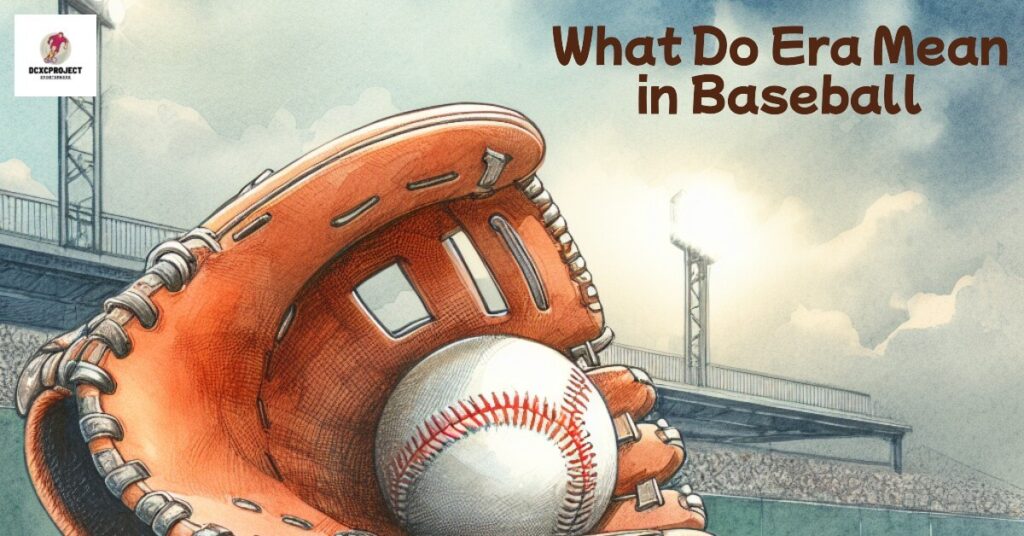What Do Era Mean in Baseball? ERA, or Earned Run Average, is a crucial pitching statistic in the sport. It measures the average number of earned runs a pitcher gives up per nine innings, offering a valuable perspective on their performance and effectiveness.
Baseball enthusiasts and analysts often refer to ERA as an essential pitching statistic, offering insights into a pitcher’s performance. It helps gauge a pitcher’s ability to prevent the opposing team from scoring runs, providing a clear indication of their overall effectiveness during a game.
Teams rely on ERA to assess the proficiency of their pitchers and make strategic decisions. Understanding ERA is crucial for following and analyzing baseball games, as it illuminates the impact of a pitcher’s performance on the overall match outcomes.
Defining Era
In baseball, ERA stands for Earned Run Average, which is a key statistical metric used to evaluate a pitcher’s performance. It represents the average number of earned runs a pitcher allows per nine innings pitched. Understanding ERA is crucial for both fans and analysts to assess a pitcher’s effectiveness on the field.
Explaining ‘earned Run Average’
ERA is calculated by dividing the total number of earned runs allowed by a pitcher by the total innings pitched and then multiplying by nine. Earned runs are those runs that are scored without the aid of an error or passed ball. This distinction is important as it focuses solely on the pitcher’s performance, excluding any defensive errors that may have occurred during the game.
Significance In Baseball Statistics
ERA holds significant weight in baseball statistics as it provides a clear measure of a pitcher’s effectiveness. It allows comparisons between different pitchers and serves as a valuable tool for evaluating their performance over time. A low ERA indicates a pitcher’s ability to prevent runs and is often indicative of high skill and consistency.
Calculating Era
Calculating ERA (earned run average) is an essential metric in baseball that measures a pitcher’s effectiveness in preventing runs. Understanding how ERA is calculated and its significance in evaluating a pitcher’s performance is crucial for both players and enthusiasts. In this section, we will delve into the formula for calculating ERA, understanding the calculations involved, and the importance of accurate calculations.
Formula For Calculating Era
ERA is determined by dividing the total earned runs by the number of innings pitched and multiplying by nine. The formula for calculating ERA can be represented as:
| Calculation: | Formula |
|---|---|
| ERA | (Earned Runs ÷ Innings Pitched) x 9 |
Understanding The Calculations
Understanding the calculations involved in determining ERA is vital for accurately assessing a pitcher’s performance. By comprehending the formula and how it relates to the total earned runs and innings pitched, individuals can gain insights into a pitcher’s overall effectiveness on the field.
Importance Of Accurate Calculations
Accurate calculations of ERA are crucial as they provide valuable data for evaluating a pitcher’s skill and performance. The ERA serves as a tool for comparing and ranking pitchers, enabling teams and analysts to make informed decisions about player lineup and strategy based on their performance.
Interpreting Era Stats
Interpreting ERA stats in baseball is essential for understanding a pitcher’s performance and effectiveness on the mound. ERA, which stands for Earned Run Average, is a fundamental metric that measures a pitcher’s ability to prevent opponents from scoring. By analyzing and comparing ERA statistics, we can gain valuable insights into a pitcher’s skill and impact on the game. In this article, we will delve into the interpretation of ERA stats, including what constitutes a good ERA, comparing different ERA statistics, and exploring the real-world implications of ERA stats.
What Constitutes A Good Era?
A good ERA in baseball is typically considered to be below 4.00, although this can vary based on factors such as the era in which the pitcher is playing and the specific league or park in which the games are being played. A low ERA indicates that a pitcher is adept at minimizing the number of earned runs scored by the opposing team.
Comparing Different Era Statistics
When comparing different ERA statistics, it’s important to consider the context in which the data is being analyzed. Traditional ERA measures the average number of earned runs a pitcher allows per nine innings pitched. However, advanced metrics such as adjusted ERA (ERA+) take into account external factors like the pitcher’s home ballpark and the overall run-scoring environment. This provides a more comprehensive understanding of a pitcher’s performance relative to their peers.
Real-world Implications Of Era Stats
ERA stats play a crucial role in evaluating a pitcher’s value and impact on the game. A low ERA can signify a pitcher’s ability to consistently limit the opposing team’s scoring, making them a valuable asset to their team. Furthermore, pitchers with impressive ERA stats are often regarded as key contributors to their team’s success, especially in high-stakes situations such as playoff games and championship series.
Factors Affecting Era
ERA, or Earned Run Average, is a key statistic in baseball that represents the average number of earned runs a pitcher allows per nine innings. Several factors affect ERA, including the pitcher’s skill, the team’s defense, and the playing environment, making it an important measure of a pitcher’s performance.
Pitchers in baseball are constantly evaluated based on statistics such as ERA (Earned Run Average). The ERA is a key indicator of a pitcher’s performance, reflecting their ability to prevent opponents from scoring runs. There are several factors that directly affect a pitcher’s ERA, including their pitching and defensive skills, the impact of playing conditions, and the evolution of ERA in modern baseball.
Pitching And Defensive Skills
A pitcher’s ERA is influenced by their individual pitching and defensive abilities. The quality of their pitches, control, and ability to strike out opponents all play a crucial role in determining their ERA. Additionally, the effectiveness of the team’s defense in supporting the pitcher by making crucial plays also impacts the pitcher’s ability to maintain a low ERA.
Impact Of Playing Conditions On Era
The playing conditions, such as the ballpark dimensions, altitude, weather, and wind direction, can significantly affect a pitcher’s ERA. Certain ballparks may be more hitter-friendly, leading to more runs being scored and consequently impacting a pitcher’s ERA. Weather conditions like wind speed and temperature can also influence the trajectory and speed of the ball, directly impacting a pitcher’s performance and subsequently, their ERA.
Evolution Of Era In Modern Baseball
In modern baseball, the evaluation and interpretation of ERA have evolved due to advancements in statistical analysis and player evaluation methods. With the advent of sabermetrics, the understanding of advanced pitching metrics has grown, leading to a more comprehensive assessment of a pitcher’s performance beyond the traditional ERA calculation. This evolution has led to a more in-depth understanding of the factors that contribute to a pitcher’s ERA and has also allowed for fairer comparisons across different eras of baseball.
By understanding these factors affecting ERA, both players and enthusiasts can gain insights into the nuanced dynamics of pitching and appreciate the significance of ERA as a key metric in baseball’s statistical landscape.
Mastering Era Analysis
In baseball, Earned Run Average (ERA) is a significant statistic used to evaluate a pitcher’s performance. Mastering ERA analysis is crucial for understanding and improving pitching performance. It provides insights into a pitcher’s effectiveness in preventing opponents from scoring runs, which is essential for winning games.
Improving Pitching Performance
To improve pitching performance, pitchers must focus on minimizing the number of earned runs they allow. This can be achieved through enhanced control, developing a wider variety of pitches, and strategic placement in the strike zone. Improving physical conditioning and mental focus are equally crucial in enhancing a pitcher’s overall performance.
Strategies To Lower Era
Implementing strategic pitching techniques such as changing speeds, utilizing effective pitch sequences, and mastering the art of deception can significantly lower a pitcher’s ERA. Identifying and addressing weaknesses, consistent practice, and learning from past performances are also essential strategies for reducing ERA.
Implications Of Mastering Era Stats
Mastering ERA statistics not only improves individual performance but can also enhance a team’s chances of winning. Coaches and managers can make better in-game decisions based on a pitcher’s ERA, and it can also influence roster management and trade decisions. Additionally, players with lower ERAs often gain recognition and enhance their market value.
Frequently Asked Questions On What Do Era Mean In Baseball
What Is A Good Baseball Era?
A good baseball ERA is generally considered to be below 4. 00. It represents the average number of earned runs a pitcher allows per nine innings. A lower ERA indicates better pitching performance.
What Does 0 Era Mean In Baseball?
A 0 ERA in baseball means a pitcher has not allowed any earned runs in a game.
Who Has The Best Era In Baseball?
The pitcher with the best ERA in baseball is the one who has allowed the fewest earned runs per nine innings pitched.
What Is The Lowest Era In MLB History?
The lowest ERA in MLB history is 0. 86. ERA measures a pitcher’s average earned runs allowed per nine innings.
Conclusion
Understanding the ERA in baseball is crucial for evaluating a pitcher’s performance. It reflects the average number of earned runs allowed per nine innings. As a foundational statistic, ERA provides valuable insights into a pitcher’s effectiveness on the field, making it an indispensable tool for both fans and professionals alike.

